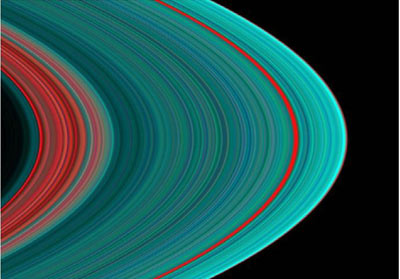The brilliant minds at JPLby Anthony Young
|
| JPL’s roster of spacecraft is a proverbial what’s what of space exploration that has vastly expanded our knowledge of our solar system. |
If proof was needed that JPL was getting the hang of orbital mechanics, Voyager 1 and 2 did just that. Launched in the late summer of 1977 within weeks of each other, the two probes made for the outer planets Saturn and Jupiter. Two years later they were returning stunning images from the planetary giants. Voyager 2 then went on to an encounter with Uranus in 1986 and a flyby of Neptune and its moon, Triton, in 1989. JPL engineers were busy during the 1980s working on the Magellan probe destined for Venus, with Galileo targeted for Jupiter and its moons to be launched later that decade; both probes have been successful in returning images of these planets and their moons that are unsurpassed.
Mars became a new focus of attention during 1990s but successful exploration of the Red Planet met with mixed success. The Mars Observer launched in 1992 was lost the following year during orbit insertion. The Mars Global Surveyor, launched in 1996, has been successfully mapping the planet since 1999. The Mars Pathfinder was the brave attempt to build a small rover with a degree of artificial intelligence to self-navigate and succeeded in achieving many milestones during 1997. However, the Mars Climate Observer and the Mars Polar Lander were both lost during their rendezvous with the planet in 1999. The new millennium brought successes: Mars Odyssey entered orbit in 2001 and its science mission began the following year. Most dramatic was the successful landing and deployment of the rovers Spirit and Opportunity in January 2004 that continue to amaze the world with their superb images and rugged durability, far surpassing their proscribed mission length.
Of course, Cassini has been performing the dance of the spheres with Saturn and its moon Titan, Venus, Jupiter and even Earth; the ESA-built Huygens decent probe will be deployed from Cassini early next year. There are many more impressive JPL missions too numerous to mention.
Cosmic eye candy
Two books I have been reading renewed my admiration for the brilliant minds at the Jet Propulsion Laboratory. The first is Andrew Mishkin’s Sojourner: An Insider’s View of the Mars Pathfinder Mission. (See “Review: recalling Sojouner”, The Space Review, December 22, 2003). It is a good first-person account of how dreams and prototypes become interplanetary reality at JPL, at least with regard to the Pathfinder/Sojourner mission. While most of the engineers at JPL have labored in relative obscurity over the past 20 years, Mishkin’s book brings the names and faces (with photos) to JPL’s planetary missions. With the successful landing and deployment of the Martian rovers Spirit and Opportunity, many JPL engineers experienced the most rewarding time of their career. They also found themselves on the evening news.
The second book is Beyond: Images of the Interplanetary Probes by Michael Benson and published by Harry N. Abrams last year. There is perhaps no better book illustrating the amazing images sent back by JPL’s spacecraft over the last 40 years. Worthy of any coffee table, sumptuous is the best word I can think of to describe this book. The photos themselves can only be viewed in wonder, as the stark beauty of the Moon and planets is brought sharply into focus and color. The vast majority of photos printed in this book are actually mosaics that have been painstakingly pieced together and digitally processed into a single seamless image. The level of work necessary to achieve this is too long to describe here, but rest assured the results are wondrous. From the high contrast images from the Lunar Orbiter in 1966 and 1967 (with the multiple image lines we are all familiar with virtually absent) to the beautiful blue of Neptune with white clouds streaking above its surface, each photograph is practically a work of art.
| The photos themselves can only be viewed in wonder, as the stark beauty of the Moon and planets is brought sharply into focus and color. |
Almost forgotten among these high-profile missions was a probe called NEAR (for Near Earth Asteroid Rendezevous) Shoemaker. Engineered by the Johns Hopkins University Applied Physics laboratory and launched in 2000, JPL provided navigation and communications support. The last object of Shoemaker’s observation was asteroid 433, known as Eros. It began orbiting Eros in February 2000 and one year later made a controlled descent to its surface, taking pictures all the way and sending them to Earth. They are in this book too.
Arthur C. Clarke wrote the forward to the book, and was so moved by the photographs he saw, he exclaimed, “These images are a spectacular reaffirmation that we are privileged to live in the greatest age of exploration the world has ever known.” Beyond will give you a renewed appreciation for the amazing work being performed at JPL (and APL) as well as the beauty of our solar system.
